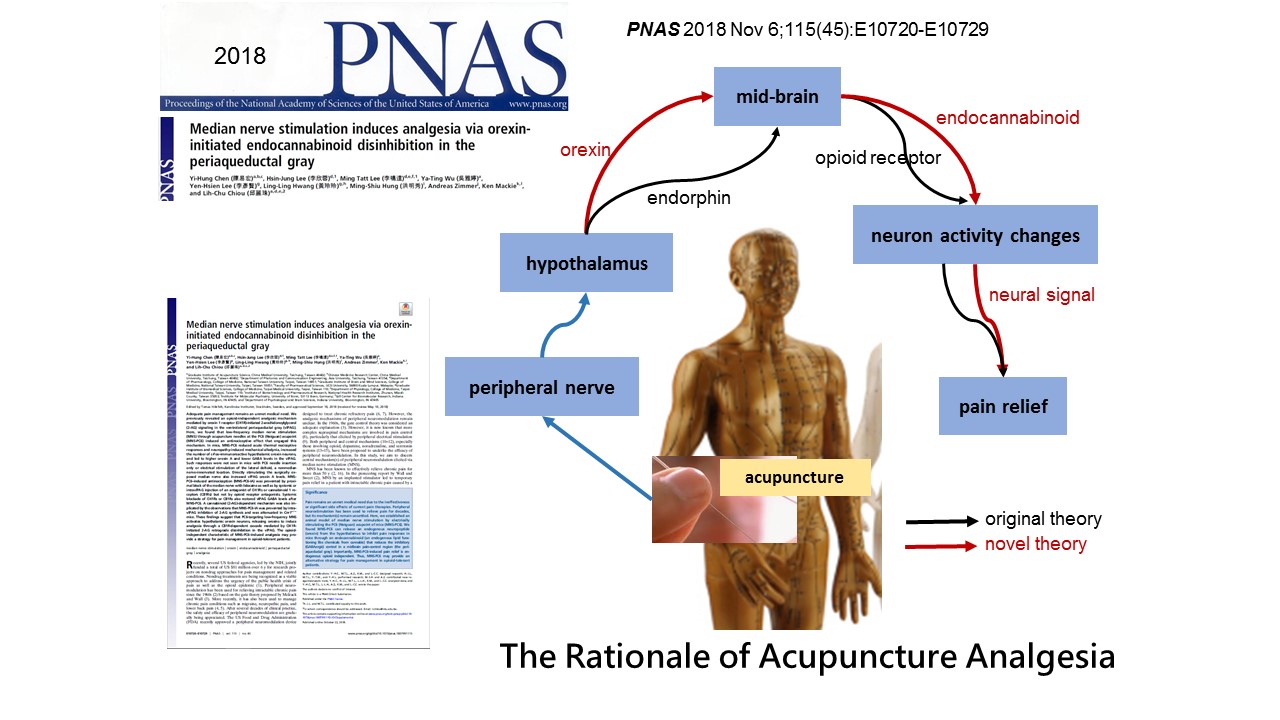The discovery of novel mechanism of acupuncture analgesia: the non-opioid neural pathway in CNS_ Yi-Hung Chen
【The discovery of novel mechanism of acupuncture analgesia: the non-opioid neural pathway in CNS_ Yi-Hung Chen】
Professor Yi-Hung Chen
Traditional Chinese acupuncture has a history of over 2,500 years. It is now accepted as a conventional treatment in the Western countries. The WHO has published guidance describing the efficacy of acupuncture in the cure or relief of 64 different symptoms. Among these indications, pain is the most important. As to the mechanism of acupuncture analgesia, the endorphins theory has been raised for a long time. However, the mechanism(s) remain unsettled. Here, we established an animal model by electroacupuncture at the PC6 (Neiguan) acupoint of mice (EA-PC6). We found EA-PC6 can release an endogenous neuropeptide (orexin) from the hypothalamus to inhibit pain responses in mice through an endocannabinoid (an endogenous lipid functioning like chemicals from cannabis) in a midbrain pain-control region (the periaqueductal gray). Importantly, EA-PC6–induced pain relief is endogenous opioid independent. Thus, EA-PC6 may provide an alternative strategy for pain management in opioid-tolerant patients. (PNAS November 6, 2018 115 (45) E10720-E10729)
發現電針止痛新之新機轉:非內生性鴉片之中樞神經路徑
針灸在中醫使用已逾2500年,目前許多西方國家也逐漸將針灸納入常規醫療方法,世界衛生組織明訂針灸可用於治療64種疾病,而其中以疼痛為最主要的適應症。有關針灸治療疼痛的機轉,雖然以腦內啡理論最廣為接受,但目前未能全面明瞭其作用。我們研究發現,電針小鼠內關穴後,經由刺激正中神經,導致下視丘神經元釋放一種名為食慾素( orexin )的神經胜肽至中腦導水管周圍灰質(periaqueductal gray),進一步促進內生性大麻釋放,進而減少抑制性的神經元活性,最終促成止痛作用,並且該止痛作用機制與腦內啡無關,新發現的針灸止痛機轉,與腦內啡引發止痛的神經路徑是不同的,2者都是與針灸止痛有關的中樞神經機轉。此發現另一個意義是可能為對於臨床上對於嗎啡產生耐受性的病人,提供另一項治療方法,因為機轉路徑不同,預期對於嗎啡產生耐受性的病人,仍然能夠以活化食慾素神經元的神經路徑進行止痛。(PNAS November 6, 2018 115 (45) E10720-E10729)
